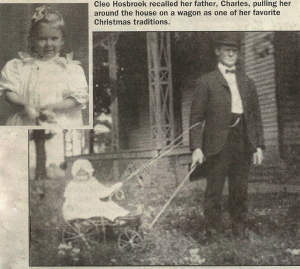By Regina Villiers. Originally published December 11, 1996 in The Suburban Life, added December 13, 2014
From what I read and hear, the hot toys this Christmas are Tickle Me Elmo, Holiday Barbie and Nintendo 64. As this information rolls over and over in my mind, I start to wonder what the hot toys were a hundred Christmases ago.
A hundred years ago, did kids suffer through interminably long days in a countdown to Christmas? And when the day finally arrived, what was it like for kids? Did they have Christmas trees? How did they celebrate?
I’m lucky enough to have received a first-hand account from someone who celebrated Christmases almost a hundred years ago. Miss Cleo J. Hosbrook, the last member of Madeira’s founding family was my friend for many years. Before her death, two years ago, when she was in her 90’s she passed on to me many stories of her life and times, as well as trinkets, pictures and bits of memorabilia from her life.
About five or six years ago, after she was living in a nursing home, I sat down with her to talk about Christmas and her memories of her childhood. At first, her memories came slowly. Yes, she told me, she did get toys at Christmas, though she couldn’t remember specific ones, except for dolls.
“I always had dolls,” she said. Then her eyes brightened. “And I remember puppies and kittens. Real ones,” she said. She always loved animals, and her life was marked by a long succession of pets.
But the best presents of all at Christmas, she told me, were lovingly made and handcrafted by parents for their children. Some of it came from necessity, with families who didn’t have much, but it was also an honored tradition with affluent families who could afford luxuries. It was just something they did for their child; a bit of themselves the child could keep forever, a family heirloom.
All through the year, mothers would sew clothes, complete wardrobes for their daughters’ dolls. And some even made the dolls. And fathers made gifts too. Miss Hosbrook was certain of that. She still had, perfectly preserved in tissue paper, a scrapbook made by her grandfather, Joseph Muchmore, for his little daughter, Maude, who was Miss Hosbrook’s mother.
This book would be well over 100 years old now, for Maude was born in 1874. The book, beautifully embossed, is filled with greeting cards, postcards, pictures of the era and bits of memorabilia from Maude’s childhood. All had been neatly pasted down by her father. The title page, beautifully hand-lettered in decorative, embellished script in black and red ink, reads: “To Maude, from her father. A merry Christmas and a happy new year.”
It must have taken him months of painstaking labor to finish it. But it was obviously the most appreciated gift of his daughter’s lifetime. Maude’s husband, Charles, had continued the tradition by making a similar book for their little daughter, Cleo. Not quite as ornate as the Muchmore book made for Maude, it is nonetheless a loving gift to a daughter and an important historical document of a bygone age.
By the time I got around to asking her about Christmas trees, Miss Hosbrook had warmed to the subject of long ago Christmases. “Oh, my yes. We did have Christmas trees,” she said. “The tree was the most important part of Christmas.”
“When I was a little girl,” she told me, “My father would take me out to the (Hosbrook) farm to get our tree. We’d search until we found a perfect tree. He’d cut out the top, and we’d bring the top home to use.” Then the tree would be set up in the living room and decorated, she told me.
She explained that real candles were used on the tree. They were about three inches long and sat on little plate-like holders. She described the room layout of their home and how it was possible to open doors and go from room to room in a large circle. “Then my father would put me in my little red wagon,” she said, “and then would come the highlight of Christmas, the lighting of the candles on the tree. He’d light them, and then he’d pull me in my wagon around and around through the house and around and around the tree, as the candles burned.”
Her eyes absolutely glowed as she told me about it. The memory came back for her, crystal clear. Pictures of her father pulling her in that little, red wagon exist. A rope is tied to his arm, as a rein, and she holds on to it, driving her always “horse and carriage.” She was obviously her father’s daughter, from her stories and from pictures and papers left behind.
Ninety years from now, I wonder how many people will sit down with someone and tell about the Christmas they received a Tickle Me Elmo. Or a Holiday Barbie. Or a Nintendo 64. Will their eyes glow, as they tell how they went with their parents to gather in the Christmas tree? And will any of them still have, preserved in tissue paper, a handcrafted gift, the result of hours and hours of loving labor by a parent? To be passed on and cherished throughout the ages? I wonder…
